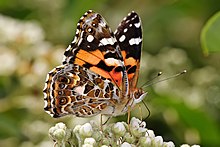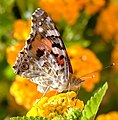
Lepidoptera is an order of insects that includes butterflies and moths. About 180,000 species of the Lepidoptera are described, in 126 families and 46 superfamilies, 10 percent of the total described species of living organisms. It is one of the most widespread and widely recognizable insect orders in the world. The Lepidoptera show many variations of the basic body structure that have evolved to gain advantages in lifestyle and distribution. Recent estimates suggest the order may have more species than earlier thought, and is among the four most species-rich orders, along with the Hymenoptera, Diptera, and Coleoptera.
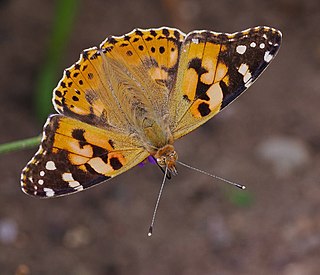
Cynthia is a group of colourful butterfly species that used to be considered a subgenus of the genus Vanessa, in the family Nymphalidae. Before that, it was first described as a genus. Nowadays, this group is not considered a valid taxon anymore, because it is paraphyletic. The name CynthiaFabricius, 1807 is now a junior subjective synonym of VanessaFabricius, 1807.

Vanessa atalanta, the red admiral or, previously, the red admirable, is a well-characterized, medium-sized butterfly with black wings, red bands, and white spots. It has a wingspan of about 2 inches (5 cm). It was first described by Carl Linnaeus in his 1758 10th edition of Systema Naturae. The red admiral is widely distributed across temperate regions of North Africa, the Americas, Europe, Asia, and the Caribbean. It resides in warmer areas, but migrates north in spring and sometimes again in autumn. Typically found in moist woodlands, the red admiral caterpillar's primary host plant is the stinging nettle ; it can also be found on the false nettle. The adult butterfly drinks from flowering plants like Buddleia and overripe fruit. Red admirals are territorial; females will only mate with males that hold territory. Males with superior flight abilities are more likely to successfully court females. It is known as an unusually calm butterfly, often allowing observation at a very close distance before flying away, also landing on and using humans as perches.

The Nymphalidae are the largest family of butterflies, with more than 6,000 species distributed throughout most of the world. Belonging to the superfamily Papilionoidea, they are usually medium-sized to large butterflies. Most species have a reduced pair of forelegs and many hold their colourful wings flat when resting. They are also called brush-footed butterflies or four-footed butterflies, because they are known to stand on only four legs while the other two are curled up; in some species, these forelegs have a brush-like set of hairs, which gives this family its other common name. Many species are brightly coloured and include popular species such as the emperors, monarch butterfly, admirals, tortoiseshells, and fritillaries. However, the under wings are, in contrast, often dull and in some species look remarkably like dead leaves, or are much paler, producing a cryptic effect that helps the butterflies blend into their surroundings.

The small heath is a butterfly species belonging to the family Nymphalidae, classified within the subfamily Satyrinae. It is the smallest butterfly in this subfamily. The small heath is diurnal and flies with a noticeable fluttering flight pattern near the ground. It rests with closed wings when not in flight. It is widespread in colonies throughout the grasslands of Eurasia and north-western Africa, preferring drier habitats than other Coenonympha, such as salt marshes, alpine meadows, wetlands, and grasslands near water. However, habitat loss caused by human activities has led to a decline in populations in some locations.

Vanessa cardui is the most widespread of all butterfly species. It is commonly called the painted lady, or formerly in North America the cosmopolitan.
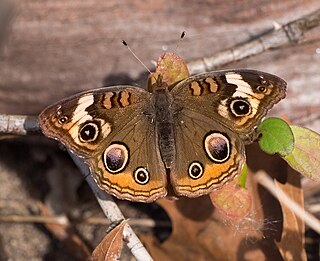
Junonia coenia, known as the common buckeye or buckeye, is a butterfly in the family Nymphalidae. It is found in the United States east of the Rocky Mountains and in Mexico. Its habitat is open areas with low vegetation and some bare ground. Its original ancestry has been traced to Africa, which then experiences divergence in Asia. The species Junonia grisea, the gray buckeye, is found west of the Rocky Mountains and was formerly a subspecies of Junonia coenia.

Heliconius charithonia, the zebra longwing or zebra heliconian, is a species of butterfly belonging to the subfamily Heliconiinae of the family Nymphalidae. It was first described by Carl Linnaeus in his 1767 12th edition of Systema Naturae. The boldly striped black and white wing pattern is aposematic, warning off predators.

The grayling or rock grayling is a species in the brush-footed butterfly family Nymphalidae. Although found all over Europe, the grayling mostly inhabits coastal areas, with inland populations declining significantly in recent years. The grayling lives in dry and warm habitats with easy access to the sun, which helps them with body temperature regulation.

Vanessa indica, called the Indian red admiral or the Asian admiral in the United States, is a butterfly found in the higher altitude regions of India, primarily the Himalayas and the Nilgiri Hills. It is also found in Sri Lanka and Myanmar, China, Korea, SE Russia, Japan. It is a close relative of the painted lady.

Vanessa is a genus of brush-footed butterflies in the tribe Nymphalini. It has a near-global distribution and includes conspicuous species such as the red admirals, the Kamehameha, and the painted ladies of the Cynthia group : Painted lady, American painted lady, West Coast lady, Australian painted lady, etc. For African admirals, see genus Antanartia. Recently, several members traditionally considered to be in the genus Antanartia have been determined to belong within the genus Vanessa.

Hypolimnas bolina, the great eggfly, common eggfly, varied eggfly or in New Zealand the blue moon butterfly is a species of nymphalid butterfly found from Madagascar to Asia and Australia.

The meadow argus is a butterfly in the family Nymphalidae, commonly found in Australia and Nelsons Island. It is also known as Albin's Hampstead eye in the United Kingdom, where it has occurred only as an accidental import.

Erebiola butleri, or Butler's ringlet, is an elusive New Zealand endemic butterfly, discovered in 1879 by John Enys at the alpine pass at the head of the Rakaia River. It is the only member of the genus Erebiola.

Anartia fatima, the banded peacock, is a butterfly in the family Nymphalidae. It is commonly found in south Texas, Mexico, and Central America but most studied in Costa Rica. This butterfly prefers subtropical climates and moist areas, such as near rivers. It spends much of its time in second-growth woodlands.
The American painted lady or American lady is a butterfly found throughout North America.

Insect migration is the seasonal movement of insects, particularly those by species of dragonflies, beetles, butterflies and moths. The distance can vary with species and in most cases, these movements involve large numbers of individuals. In some cases, the individuals that migrate in one direction may not return and the next generation may instead migrate in the opposite direction. This is a significant difference from bird migration.

The dryandra moth is a species of moth that is considered to be the sole member of the family Carthaeidae. Its closest relatives are the Saturniidae and it bears a resemblance to many species of that family, bearing prominent eyespots on all wings. The common name is derived from the Dryandra shrubs of the genus Banksia, on which the larva of this species feed, and is hence restricted to the south-west of Western Australia where these shrubs grow. Other Grevillea shrubs may also be used as host plants.

Abantiades latipennis, known as the Pindi moth, is a species of moth in the family Hepialidae. It may also be referred to as a swift moth or a ghost moth, as this is a common name associated with Hepialidae. Endemic to Australia and identified in 1932, it is most populous in temperate rainforest where eucalypti are prevalent, as the larvae feed primarily on the roots of these trees. Females lay eggs during flight in a scattering fashion. The larvae live for over eighteen months underground, while adult moths survive for approximately one week, as they have no mouthparts with which to feed. The moths are preyed upon by a number of predators, including bats and owls. Brown in colour overall, males are paler and the identifying silver bars of the male's wings are more prominent than those of the female's, with dark margins. Male adults are generally smaller.

Many populations of Lepidoptera migrate, sometimes long distances, to and from areas which are only suitable for part of the year. Lepidopterans migrate on all continents except Antarctica, including from or within subtropical and tropical areas. By migrating, these species can avoid unfavorable circumstances, including weather, food shortage, or over-population. In some lepidopteran species, all individuals migrate; in others, only some migrate.
